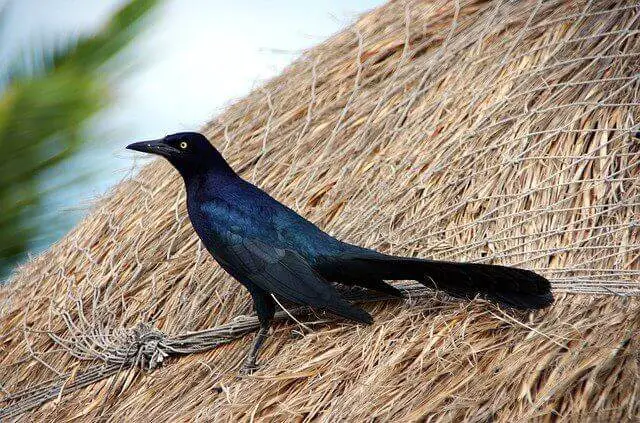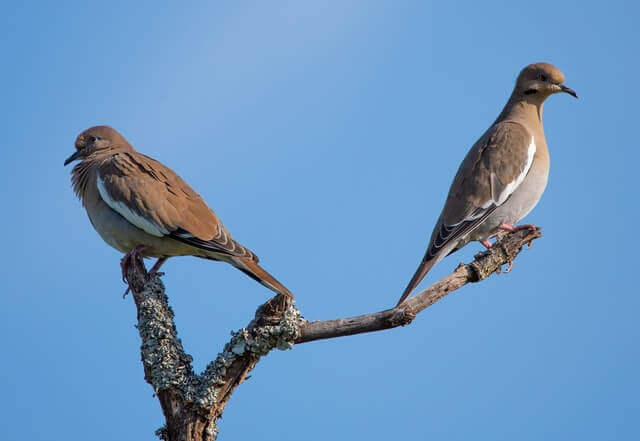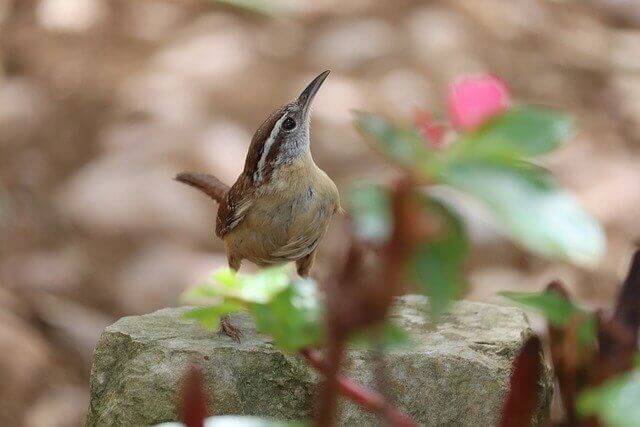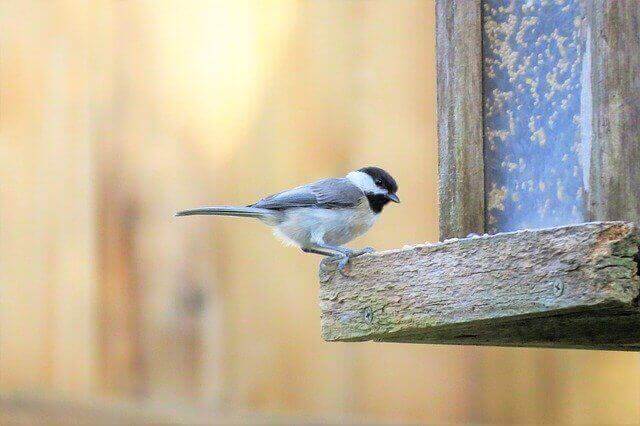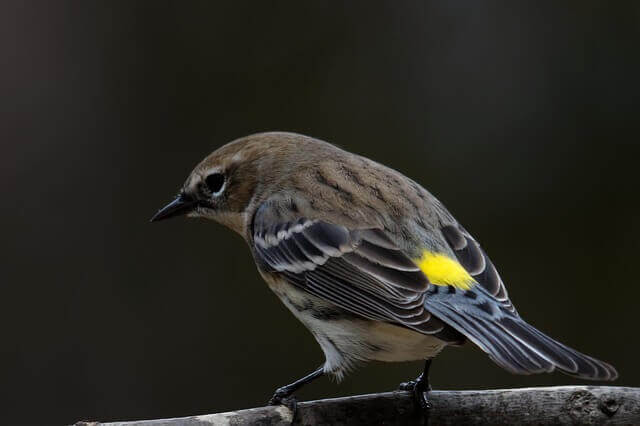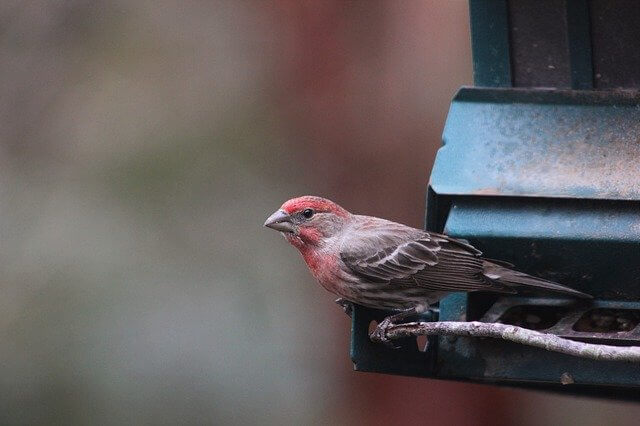Texas, with its rich tapestry of landscapes from coastal plains to forests, is a birdwatcher’s dream. This vast state offers a diverse habitat for a multitude of bird species. In this guide, we’ll take you on a journey through the 66 most common birds you can encounter in Texas, shedding light on their unique habitats and fascinating behaviors.
Table of Contents
- 1 Most Common Birds In Texas
- 1.1 Northern Cardinal
- 1.2 Northern Mockingbird
- 1.3 Mourning Dove
- 1.4 Great-tailed Grackle
- 1.5 White-winged Dove
- 1.6 Blue Jay
- 1.7 Carolina Wren
- 1.8 Carolina Chickadee
- 1.9 House Sparrow
- 1.10 Red-winged Blackbird
- 1.11 European Starling
- 1.12 Eastern Phoebe
- 1.13 Killdeer
- 1.14 American Crow
- 1.15 Yellow-rumped Warbler
- 1.16 House Finch
- 1.17 Red-bellied Woodpecker
- 1.18 Barn Swallow
- 1.19 Ruby-crowned Kinglet
- 1.20 Black-crested Titmouse
- 2 Frequently Asked Questions
- 3 Author
Most Common Birds In Texas
Northern Cardinal
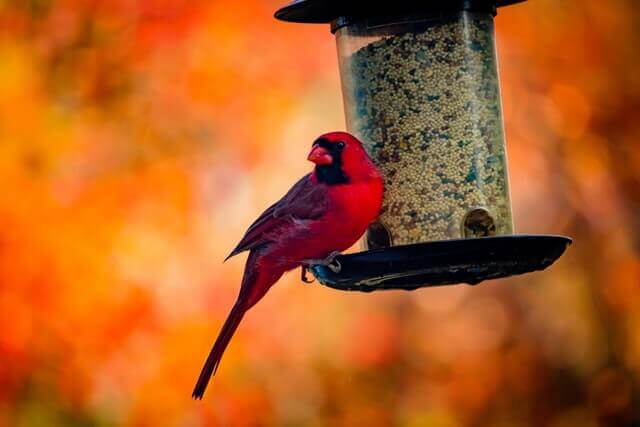
The Northern Cardinal, also called the red cardinal, is a bird native to North America known for its lovely red color. Cardinals are found in woodlands, swamps, and forests and generally prefer habitats with dense vegetation. Cardinals are not migratory birds and will stay in their territories year-round.
Cardinals are seed-eaters but will also consume insects, berries, and fruits. The northern cardinal is an important bird species in North America, and its range extends from southern Canada to Mexico.
- Frequency: 48.23% (Statistic: eBird)
- Color: Mostly red with a black mask on the face, short pink bill
- Habitat: woodlands, gardens, parks, backyards, and wetlands
- Range: USA, Canada, Mexico
- Size: 8.2 – 9.3″ inches
- Weight: 33 – 65 grams
- Diet: Fruits, berries, and insects (grasshoppers, beetles, snails, cicadas)
- Family: Cardinalidae
- Genus: Cardinalis
- Maps: Range Map – Sightings Map
- Sounds: Calls and Songs
Related:
- 10 Best Bird Feeders for Cardinals (Rated for 2022)
- Best Birdhouse for Cardinals 2022 (Tested And Rated)
- Where are Cardinal Birds Found – Best Places to Look
- Cardinal Bird Facts You Never Knew
Northern Mockingbird
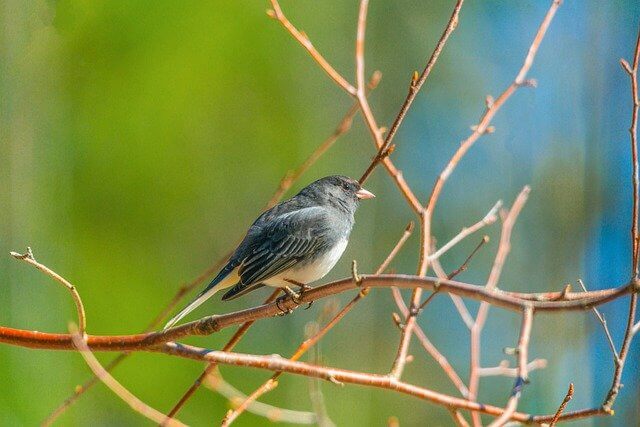
The Northern Mockingbird, is the only mockingbird found in North America. This small bird is usually a frequent visitor, but Northern Mockingbird’s can only move south during extremely harsh winter weather. In spring and early summer, these birds are mostly seen near roadways or in fields where food is gathered.
During fall and winter, they are less frequent visitors. These small birds prefer to live in fields, marshes, and wooded areas where they hunt, catch insects, eat berries, and roost.
- Frequency: 46.19%
- Color: Gray upper with white underparts. Black and white wing bars.
- Habitat: Forested areas, parks, and gardens
- Range: Southeastern Canada, USA, Northern Mexico, Cayman Islands, Greater Antilles
- Size: 8.0 – 11″ inches long
- Weight: 40 – 58 grams
- Diet: Berries, fruits, seeds, arthropods, earthworms, and occasionally lizards
- Family: Mimidae
- Genus: Mimus
- Maps: Range Map – Sightings Map
- Sounds: Calls and Songs
Related: How to Attract Mockingbirds to your Yard? (Expert Tips)
Mourning Dove
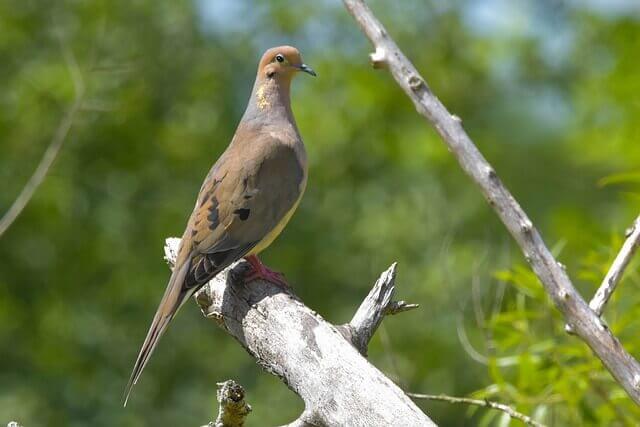
The Mourning Dove ranges from southern Canada to central Mexico, including most of the continental United States. They are a relatively small bird, with a body length of around 12 inches. Their diet consists mainly of seeds, and grains, but they will also eat insects and berries.
Mourning Doves typically nest in trees, but will also nest on the ground if necessary. The female lays two eggs at a time and incubates them for about two weeks before they hatch. Both parents help to care for the young birds until they are old enough to fend for themselves.
- Frequency: 37.37%
- Color: Light gray-brown and lighter and pinkish below. The wings have black spots.
- Habitat: Open habitats, urban areas, farms, prairie, grassland, wooded area
- Range: USA, Canada, Mexico, Central America, Greater Antilles
- Size: 12″ inches length
- Weight: 112 – 170 grams
- Diet: Rapeseed, corn, millet, safflower, sunflower seeds, poke berry, sesame, and wheat.
- Family: Columbidae
- Genus: Zenaida
- Maps: Range Map – Sightings Map
- Sounds: Calls and Songs
Related:
- Facts About Mourning Doves – 10 Things You Need To Know!
- Best Bird Feeder For Doves (Reviewed & Tested for 2022)
Great-tailed Grackle
The Great-tailed grackle is a diverse bird with a wide range of habitats across the Americas, including Central and South America, Caribbean, Central and Western Africa, and Southeast Asia, the great-tailed grackles feed on a variety of foods. Their diet includes ants, spiders, mites, worms, and leeches. They also consume berries, suet, berries, wheat and fruits, leaf buds, and berries.
Nests are located in fields, brushlands, fields near crop fields, riparian forests, thickets, marshes, along rivers, ditches, etc., and these birds spend most of their time during the day roosting or building their nests.
- Frequency: 29.86%
- Color: Iridescent black with a purple-bluish sheen on the head and upper body
- Habitat: Urban settings, wetlands, pastures, chaparral and mangroves.
- Range: North America, South America, Central America
- Size: 15 – 18″ inches
- Weight: 203 – 265 grams
- Diet: Seeds and insects (butterflies, dragonflies, moths, frogs, worms, spider, snails, carrion, flies.)
- Family: Icteridae
- Genus: Quiscalus
- Maps: Range Map – Sightings Map
- Sounds: Calls and Songs
White-winged Dove
The white-winged dove has long been one of North America’s most popular birds. Unlike most doves, the white-winged doves’ primary means of nesting is in caves. They will also nest in rock crevices, inside and under trees, on ledges, in houses, and hollow trees, in all areas where there are places for them to build their nests.
They will eat just about anything, and their diet will consist mostly of seeds, grains, and fruits. However, they will also eat any small insects that are around.
- Frequency: 29.84%
- Color: Brownish-gray on top and gray below, with a white wing patch that looks like a brilliant white crescent
- Habitat: Scrub, woodlands, desert, urban, and cultivated areas.
- Range: Texas, Mexico, Central America and the Caribbean.
- Size: 11″ inches length
- Weight: 150 grams
- Diet: Variety of seeds, grains, and fruits.
- Family: Columbidae
- Genus: Zenaida
- Maps: Range Map – Sightings Map
- Sounds: Calls and Songs
Blue Jay
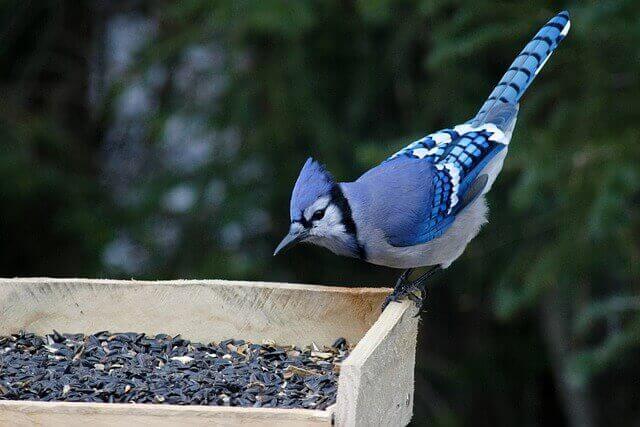
The blue jay is a bird that is found in North America. It is most commonly seen in the eastern and central parts of the continent, but its range also extends into the western part of the continent.
The blue jay is a very adaptable bird and can be found in a variety of habitats, including forests, gardens, and even urban areas. The diet of the blue jay consists mainly of insects, but it will also eat fruits, nuts, and seeds.
- Frequency: 25.61%
- Color: Blue crest on the head, wings, back, and tail, and has a white face and belly
- Habitat: Deciduous and mixed forests, mixed woodlands, backyards, parks
- Range: Southern Canada, Eastern and Central United States, Florida and Texas
- Size: 8 – 12″ inches
- Weight: 70 – 100 grams
- Diet: Nuts, seeds, caterpillars, grasshoppers, and beetles
- Family: Corvidae
- Genus: Cyanocitta
- Maps: Range Map – Sightings Map
- Sounds: Calls and Songs
Related:
- How to Attract Blue Jays to your Yard?
- 15 Best Bird Feeders For Blue Jays (Tried & Tested 2022)
- Do Blue Jays Migrate? The Truth
- What do Blue Jay Eat – All The Facts
Carolina Wren
The Carolina Wren is an uncommon species of wren, which is primarily a resident in the southern half of the United States of America east of the extreme north of Labrador, Canada, and along the Gulf of Mexico.
There are no known migratory paths for the Carolina wrens, but during late winter and early spring, they take flight for northern areas where they feed on wood-like leafed trees, and in the southern parts they feed on evergreen shrubs and plants. During the time of nesting male Carolina wrens choose a sheltered location such as a clearing in a tree trunk, tall plant.
- Frequency: 24.91%
- Color: Black cap and throat with white cheeks. Light gray wings, back, and tail.
- Habitat: Deciduous forests, suburbs, parks, backyards
- Range: USA (Texas, Florida, New Jersey, and Kansas)
- Size: 4.5 – 5.1″ inches long
- Weight: 9 – 12 grams
- Diet: Insects, berries, seeds
- Family: Paridae
- Genus: Poecile
- Maps: Range Map – Sightings Map
- Sounds: Calls and Songs
Related: How to Attract Wrens to your Backyard? (Expert’s Guide)
Carolina Chickadee
The Carolina Chickadee (Poecile carolinensis) is a small, North American songbird. It ranges from southern Canada to northern Florida, and west to the Great Plains. Carolina Chickadees are found in woodlands, including deciduous, mixed, and coniferous forests.
These birds sometimes make their nest in tree hollows, and may also use birdhouses as dens instead. Carolina Chickadees eat insects, spiders, seeds, and berries. They will often store food for later use.
- Frequency: 24.86%
- Color: Black cap and throat with white cheeks. Light gray wings, back, and tail.
- Habitat: Deciduous forests, suburbs, parks, backyards
- Range: USA ( Texas, Florida, New Jersey, and Kansas)
- Size: 4.5 – 5.1″ inches long
- Weight: 9 – 12 grams
- Diet: Insects, berries, seeds
- Family: Paridae
- Genus: Poecile
- Maps: Range Map – Sightings Map
- Sounds: Calls and Songs
Related:
- Carolina Chickadees – 9 Best Ways To Attract Them Fast!
- Best Bird Feeder For Chickadees (The Ultimate Guide 2022)
House Sparrow
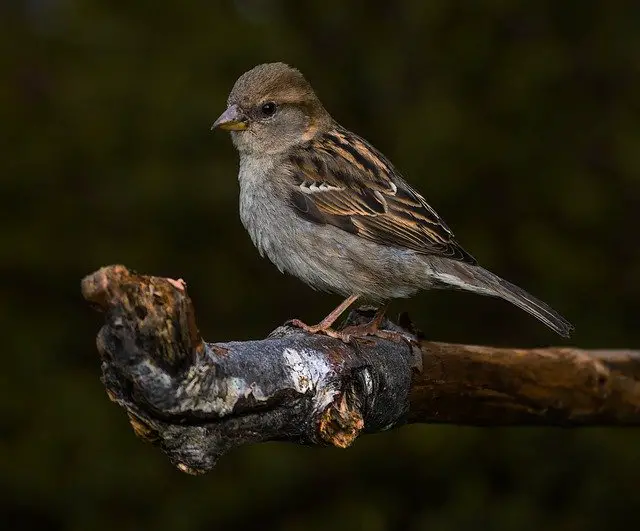
The house sparrow is an extremely common bird of the swallow family, found in all parts of North America. It is a fairly small, nimble little bird with a typical average length of just 5.5 – 7.1 inches and a weight of just 24 grams.
The House Sparrow is particularly active during the spring and early summer, when they feed on nectar and take up shelter in tree branches and old wallsop piles. In late summer and fall, they are more sedentary and feed less, spending more time on the trees and along the edges of trees.
- Frequency: 23.71%
- Color: Gray head marking, a reddish-brown back, and gray underparts
- Habitat: Urban centers, suburban areas, backyards, edges, yards, and parks
- Range: North America, Central America, South America, Africa, Australia, New Zealand
- Size: 5.5 – 7.1″ inches in length
- Weight: 25 – 39 grams
- Diet: Insects, beetles, caterpillars, aphids,, grasshoppers, crustaceans, earthworms, vertebrates
- Family: Passeridea
- Genus: Passer
- Maps: Range Map – Sightings Map
- Sounds: Calls and Songs
Related: How to Attract Sparrows to your Backyard
Red-winged Blackbird
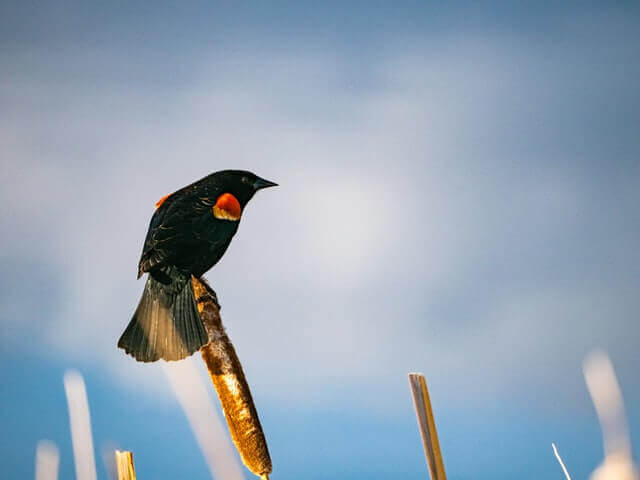
Red-winged blackbirds are found in wetland habitats across North and South America. These birds get their name from the red and yellow patches on their wings. Male red-winged blackbirds are all black with these bright red and yellow markings, while females are mostly brown. Red-winged blackbirds eat a variety of insects, spiders, and other small animals.
They also eat some seeds and berries. In the winter, when insect food is scarce, they will eat more seeds. Red-winged blackbirds often eat while they are flying. These birds build their nests in trees or shrubs near water. The female builds the nest by herself, using twigs, grasses, and leaves. She lines the nest with soft materials like hair or feathers.
- Frequency: 22.09%
- Color: All black with red patches on shoulder and a yellow wing bar
- Habitat: Deciduous forests, conifers, roadside, rivers, backyards, parks
- Range: North America, Central America
- Size: 6.7 – 7.1″ inches length
- Weight: 41.5 – 65 grams
- Diet: Seeds and insects (butterflies, dragonflies, moths, frogs, worms, spider, snails, carrion, flies.)
- Family: Icteridae
- Genus: Agelaius
- Maps: Range Map – Sightings Map
- Sounds: Calls and Songs
European Starling
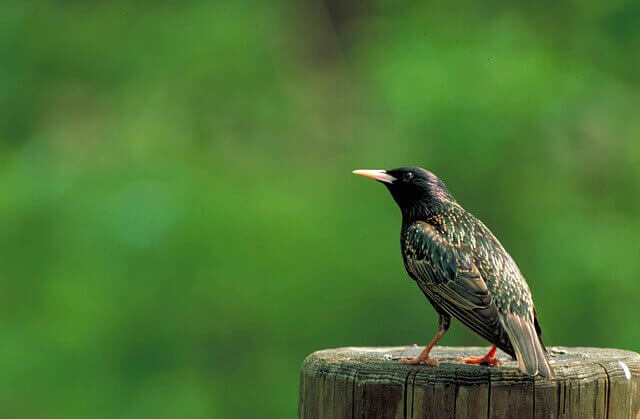
The European Starling, is a medium-sized passerine bird from the Sturnidae family, Sturnidae. You can spot them nesting in fields, on lawns, along roads and railways. They feed on a wide variety of foods including suet, berries, fruit, seeds, young seedlings, insects, and other birds.
They prefer to roosts along coastal areas or along roads and railways, so see them feeding this way if you get the chance. Also watch for European starlings during winter, as they may come down from high cliffs to roost there.
- Frequency: 21.26%
- Color: Black with glossy iridescence plumage
- Habitat: Forests, woodlands, backyards, edges, yards, and parks
- Range: North America, Europe, Africa, India, Middle East, China
- Size: 7 – 9″ inches long
- Weight: 60 – 100 grams
- Diet: Insects (ants, beetles, invertebrates), fruits, seeds, berries
- Family: Sturnidae
- Genus: Sturnus
- Maps: Range Map – Sightings Map
- Sounds: Calls and Songs
Related: How To Attract European Starlings To Your Yard Fast?
Eastern Phoebe
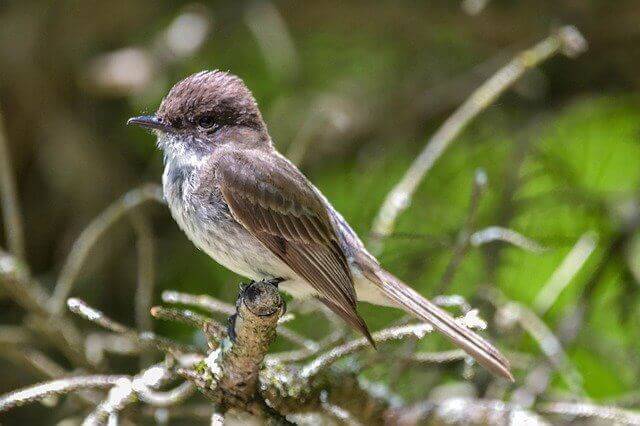
The Eastern Phoebe’s food sources tend to be limited to small berries, suet, nuts, blossoms, and nectar. The Eastern Phoebe takes up residence in thickets and woodlands. The most common habitat is rocky cliffs and low-lying swampy areas.
They prefer open, forested areas in thickets and woodlands. They also appear in grasslands and scrub. They are not very vocal, but do make some flushing sounds to attract mates.
- Frequency: 19.97%
- Color: Gray-brown upper, gray breast and underbody, white throat
- Habitat: Farmland, parks, and gardens
- Range: Southern USA and Mexico
- Size: 5.5 – 6.7″ inches long
- Weight: 16 – 21 grams
- Diet: Insects and berries
- Family: Tyrannidae
- Genus: Sayornis
- Maps: Range Map – Sightings Map
- Sounds: Calls and Songs
Related: Birds that look like Eastern Phoebe: 6 Common Types
Killdeer
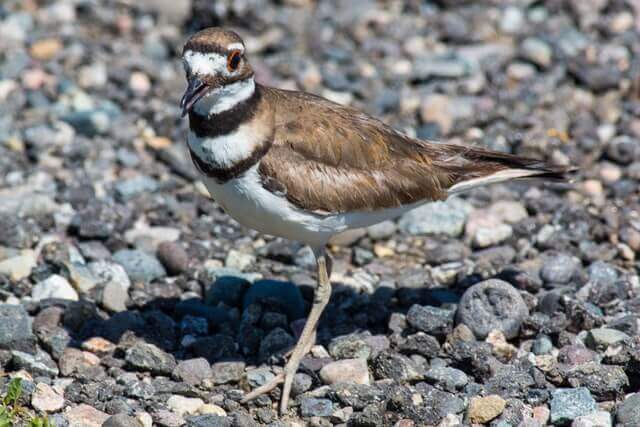
Killdeer is a large plover that ranges from eight to eleven inches in length. Like all killdeer species, Killa have distinct, colorful, patterning. The best time to feed Killdeer is in the morning after the sun has risen. Although killdeer prefer a dry and cool climate, they will feed on almost any food source available.
They can be found in marshes, meadows, fields, meadow edges, river banks, along the coast, along the coastlines, and in parks. Common killdeer feeds on insects, although other invertebrates and seeds are eaten. Most shorebirds feed near the water, so it is not uncommon to see killdeer and shorebirds feeding together.
- Frequency: 19.21%
- Color: Brownish color on top and white below. Has a white chest with two black bands, brown face is marked with black and white patches.
- Habitat: Marshes, meadows, fields, meadow edges, river banks, coastlines, and in parks.
- Range: USA, Southern Canada and Mexico
- Size: 7.9″ – 11″ inches long
- Weight: 72 – 121 grams
- Diet: Insects, invertebrates and seeds,
- Family: Tyrannidae
- Genus: Sayornis
- Maps: Range Map – Sightings Map
- Sounds: Calls and Songs
American Crow
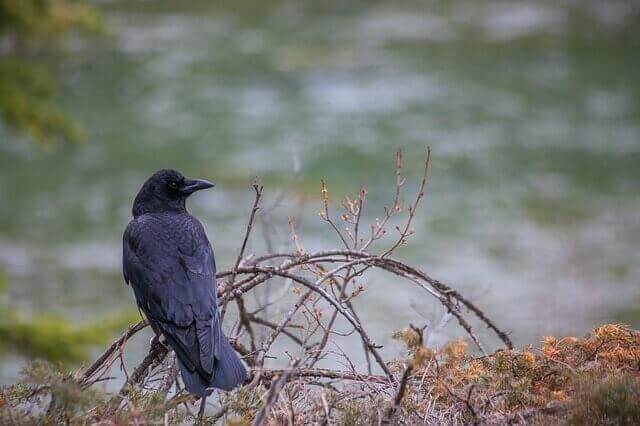
The American crow is a bird that can be found in North America. It is a member of the Corvid family, which includes ravens, jays, and magpies. The range of the American crow extends from Alaska to Newfoundland and southward into Mexico and Central America. Crows can also be found in Hawaii.
The habitat of the American crow is varied, but they are most likely to be found in woods or near farmland. The diet of the American crow consists mostly of insects, but they will also eat small mammals, reptiles, amphibians, birds, and carrion. Crows will also eat nuts, berries, and seeds.
- Frequency: 17.93%
- Color: Black
- Habitat: Open country, farms, parks, woodlands, towns, cities
- Range: Canada, USA, Mexico
- Size: 16 – 21″ inches
- Weight: 315 -620 grams
- Diet: invertebrates, carrion, seeds, eggs fish, grains, mice, frogs, and other small animals.
- Family: Corvidae
- Genus: Corvis
- Maps: Range Map – Sightings Map
- Sounds: Calls and Songs
Related: How To Attract Crows To Your Backyard: Expert Tips!
Yellow-rumped Warbler
The Yellow-rumped Warbler has long been a common North American songbird species. These birds are commonly found in open areas, forested swamps, meadows, and cliffsides. During the winter migratory seasons, they spend most of their time migrating to warmer climates.
They prefer deciduous forests, because the trees do not lose their leaves through the winter months. If you see one during the breeding season, you are sure to find at least one or more. They are very common, in southern states like Texas and Louisiana, and in the eastern parts of Florida.
- Frequency: 17.83%
- Color: Yellow patches on the crown, flanks, rump & blackish-blue streaks on the back, breast and wings
- Habitat: Deciduous forests and thickets, roadside, grasslands, backyards
- Range: U.SA, Canada, Mexico, Central America, and the Caribbean
- Size: 4.7 – 5.9″ inches
- Weight: 10 – 18 grams
- Diet: grasshoppers, gnats, aphids, caterpillars, wasps, beetles, spiders, berries,
- Family: Parulidae
- Genus: Setophaga
- Maps: Range Map – Sightings Map
- Sounds: Calls and Songs
Related: How to Attract Warblers to your Yard?
House Finch
The house finch is a member of the fringillidae family. They are extremely common birds, with nearly 25% of the entire wild population being house finches. They are well-known for their colorful markings and their adaptability to a variety of living conditions, making them a favorite among bird lovers.
They are commonly found on islands in Hawaii and on the Western North America along with some parts of Texas, Mexico, and Central America. The house finch diet consists mostly of aphids, grains, seeds, berries, nettle, dandelion, and sunflowers.
- Frequency: 16.73%
- Color: Reddish face and upper breast, brown streaks on back, belly, and tail.
- Habitat: urban and suburban areas, backyards, edges, yards, and parks
- Range: Canada, USA, Mexico
- Size: 5 – 6″ inches
- Weight: 16 – 27 grams
- Diet: Aphids, grains, seeds, berries, nettle, dandelion, sunflower
- Family: Fringillidae
- Genus: Haemorhous
- Maps: Range Map – Sightings Map
- Sounds: Calls and Songs
Related: How to Attract House Finch to Your Yard?
Red-bellied Woodpecker
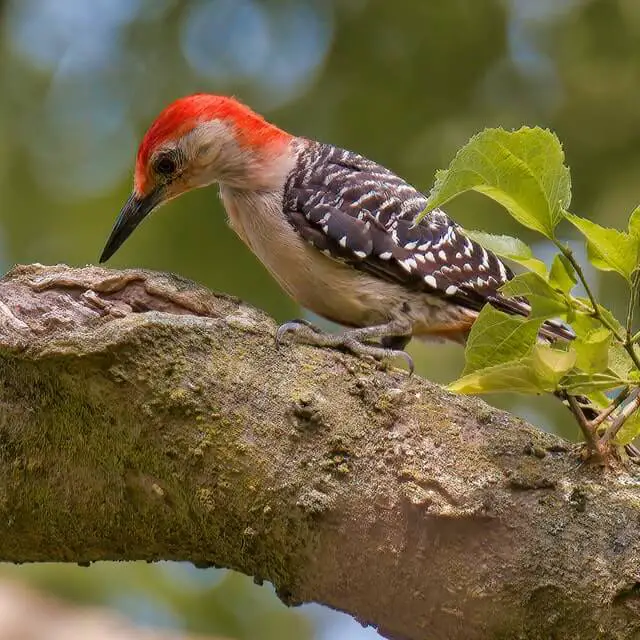
The Red-bellied Woodpecker (Melanerpes carolinus) is a medium-sized woodpecker that is native to North America. The species ranges from southeastern Canada to central Florida and west to the Great Plains. The red-bellied woodpecker is a non-migratory bird that can be found in both deciduous and coniferous forests. The bird is also known to inhabit urban areas and parks.
The preferred habitat of the red-bellied woodpecker includes trees with good access to insects. The diet of the red-bellied woodpecker consists primarily of insects, although the bird will also eat fruits, nuts, and other small invertebrates. The majority of the diet is made up of beetles, ants, wasps, and caterpillars.
- Frequency: 16.63%
- Color: Gray on body and face and underparts. Black and white pattern on wings, back, and tail.
- Habitat: Forests, backyards
- Range: Southern Canada, Eastern United States, Florida
- Size: 9 – 10.6″ inches long
- Weight: 56 -91 grams
- Diet: Insects, tree frogs, eggs of small birds, oozing sap, and small fish.
- Family: Picidae
- Genus: Melanerpes
- Maps: Range Map – Sightings Map
- Sounds: Calls and Songs
Related: How to Attract Red-bellied Woodpeckers to your Yard?
Barn Swallow
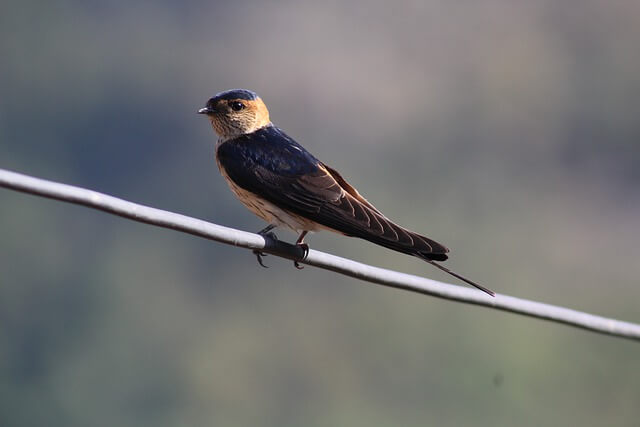
The Barn Swallow is probably the most common species of swallow in existence. It’s a very distinctive, gorgeous-looking passerine swallow with a long, strongly forked tail and blue upperparts. It’s common in North America, Africa, Europe, and Australia. When disturbed or frightened, it stands on its hind legs and raises its head high, looking quite intimidating. This is an important factor in its conservation status.
Barn Swallows is not only found near water, but they also tend to build elaborate and colorful nests in trees. The Barn Swallow prefers to build their nests near the water but will eat nearly anything including insects, aphids, and flying ants.
- Frequency: 15.97%
- Color: Has a blue back, wings, and tail, and reddish-brown underparts. Cinnamon-colored forehead.
- Habitat: Open country with low vegetation, pasture, farmland and meadows, near water sources.
- Range: North and South America, South Africa, Europe and Australia.
- Size: 6.5 – 7.5″ long
- Weight: 16 – 22 grams
- Diet: Insects, aphids, and flying ants.
- Family: Hirundinidae
- Genus: Hirundo
- Maps: Range Map – Sightings Map
- Sounds: Calls and Songs
Related: How to Attract Swallows to my Yard? (The Expert’s Guide)
Ruby-crowned Kinglet
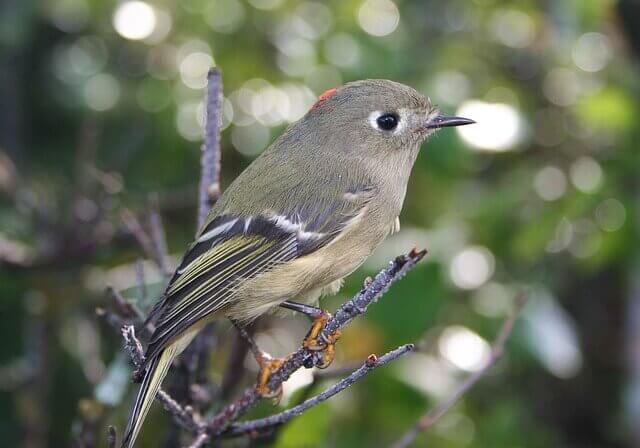
The Ruby-crowned Kinglet is a small passerine bird, often found throughout North America, from the southwestern states to the Canadian border. It is part of the kinglet family. The bird has gray-black plumage with two black wings and a white eye ring. The male has a large red band, which is often hidden, on the crown.
The female has a black throat, breast feathers, and white belly. This small bird is one of the smallest songbird in the world, weighing only about 5 grams. Its olive-green body reflects the sun’s light and produces a slight yellow glow in the underwing. The kinglet is a migratory bird, and its range extends from Canada to Mexico.
- Frequency: 15.72%
- Color: Olive-green body, with a prominent white eye ring and white wing bar.
- Habitat: Coniferous forests across Canada, Alaska, New England and the western United States
- Range: North America, Mexico
- Size: 3.5 – 4.3″ long
- Weight: 5 – 10 grams
- Diet: Insects, fruits and seeds.
- Family: Regulidae
- Genus: Regulus
- Maps: Range Map – Sightings Map
- Sounds: Calls and Songs
Black-crested Titmouse
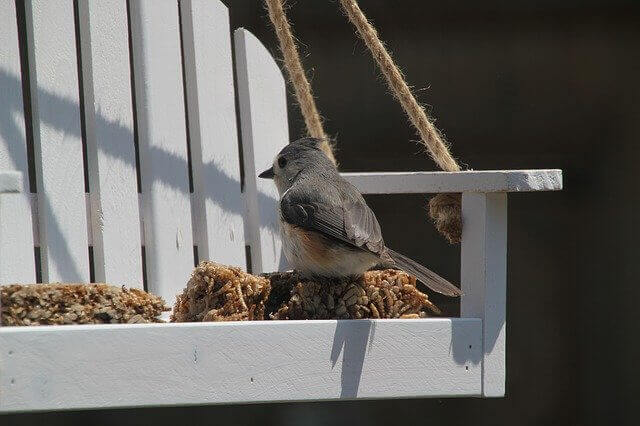
The Black-Crested Titmouse has a unique characteristic of having a yellowish throat and head with gray upperparts and an orange mid-body. Titmice are common in deciduous woods and shrubbery but are particularly abundant in fields and wooded areas during the wintertime.
They breed in all parts of the world and are particularly common in the southern United States, along the Mississippi River and in the Southern part of Ohio. In addition, they are also found in Canada, Mexico, and Arkansas. Titmice breed readily in all shade trees, but prefer the west and southwest. They nest in wooded areas, beneath fences, and in houses and decks.
- Frequency: 13.66%
- Color: Rust colored flanks, gray upper parts, and a white belly.
- Habitat: USA and Mexico
- Range: Southern Texas, Oklahoma, and east-central Mexico.
- Size: 5.5 – 6.0″ long
- Weight: 21 grams
- Diet: Insects, fruits and seeds.
- Family: Paridae
- Genus: Baeolophus
- Maps: Range Map – Sightings Map
- Sounds: Calls and Songs
The backyard birds below have a frequency of less than 13% year-round
- White-eyed Vireo 13.10% Frequency
- Downy Woodpecker 12.31%
- Blue-gray Gnatcatcher 12.13%.
- Golden-fronted Woodpecker 12.08%
- Double-crested Cormorant 12.02%
- Pied-billed Grebe 11.98%
- Scissor-tailed Flycatcher 11.91%
- Orange-crowned Warbler 11.50%
- Eastern Bluebird 11.24%
- Loggerhead Shrike 11.16%
- American Kestrel 11.15%
- Rock Pigeon 11.01%
- Brown-headed Cowbird 10.80%
- Ladder-backed Woodpecker 10.73%
- American Robin 10.63%
- Bewick’s Wren 9.82%
- Blue-winged Teal 9.68%
- Eurasian Collared-Dove 9.54%
- Tufted Titmouse 9.40%
- Savannah Sparrow 9.02%
- Cedar Waxwing 8.37%
- Purple Martin 8.34%
- Chipping Sparrow 8.32%
- Lesser Goldfinch 8.29%
- American Goldfinch 8.14%
- Belted Kingfisher 7.74%
- Lincoln’s Sparrow 7.63%
- Ruby-throated Hummingbird 7.61%
- Inca Dove 7.47%
- Chimney Swift 7.25%
- Eastern Meadowlark 6.99%
- Great Kiskadee 6.70%
- Common Grackle 6.66%
- Painted Bunting 6.54%
- Least Sandpiper 6.38%
- Common Yellowthroat 6.26%
- White-crowned Sparrow 6.25%
- Black-chinned Hummingbird 6.14%
- Greater Yellowlegs 6.12%
- Spotted Sandpiper 5.77%
- White-throated Sparrow 5.74%
- Summer Tanager 5.70%
- Lark Sparrow 5.53%
- House Wren 5.49%
- Green Jay 5.28%
- Indigo Bunting 5.09%
Frequently Asked Questions
What is a common bird in Texas?
If you’re looking for a common bird in Texas, the Northern Cardinal is a good bet. With a 49.75% frequency of occurrence, according to eBird, it is the most commonly seen bird in the state in 2022. Cardinals are easily recognizable with their bright red plumage and distinctive song. If you’re lucky enough to spot one, you’re sure to be charmed by this common Texas bird.
What are the little brown birds in Texas called?
There are two types of little brown birds commonly found in Texas – the Carolina Wren and the house sparrow. The Carolina Wren is a small songbird with a rusty-brown back and wings, and a white belly. They are one of the most common backyard birds in the state. The house sparrow is a small, stocky bird with streaked brown feathers. They are often found near human habitation, and are considered to be pests by some people.
What bird chirps at night in Texas?
The American Robin and the Northern Mockingbird are two birds that are known to chirp at night in Texas. These birds are active during the daytime and are known to sing at dawn and dusk. The American Robin is a migratory bird that can be found in woods and gardens, while the Northern Mockingbird is a permanent resident of Texas. Both of these birds are important to the ecosystem and provide a great source of entertainment for bird enthusiasts.
What is a white bird in Texas?
In Texas, there are several different types of white birds. The most common include the white ibis, American white pelican, and wood storks. All of these birds are typically found near bodies of water, as they rely on them for food.
What bird has a yellow belly in Texas?
In Texas, the five most common birds with yellow bellies are the Yellow-bellied Sapsucker, Yellow-bellied Flycatcher, Yellow-breasted Chat, Western Meadowlark and the Western Kingbird. All five of these birds are found in wooded areas throughout the state. The Yellow-bellied Sapsucker is the most common of them all.
Related Post:


